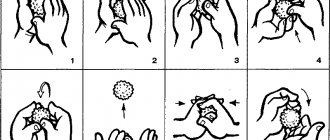The baby is growing, and the time has come to teach the child to feed himself with a spoon. This item has been of interest to the baby for a very long time; he happily grabs a teaspoon, waves it and throws it on the floor. Don't interfere with his hobby, but constantly remind him why cutlery is needed. Buy a doll set, sit the toys at the table with your child and “treat” them with delicious dishes. Do not forget that children learn from the example of adults and if they are always fed alone, they do not see how mom and dad eat - in this case, it will take a very long time to explain the rules of behavior at the table.
How easy it will be for a child to learn to eat independently depends on the diligence and tolerance of the parents. The development of each child follows a separate scenario - it is impossible to identify a clear framework for the learning period. Individual readiness is determined by the mother. The most important thing is for the child to feel comfortable during lessons.
Using a spoon is the first self-care skill
Some mothers make the mistake of not allowing their baby to develop independently. The child wants to eat with a spoon, drink from a cup, take a rag and wipe off the dust together with his mother. After such exercises, you have to wash your child and all the objects around him. There is no need to be angry with the baby, think: do you succeed in any new task the first time? Find a reason to praise him every time, tell him that today he is doing better than yesterday, and next time the baby will do his best to please his mother.
Even before one year of age, babies show a desire to do something on their own. Take this opportunity and teach him the first self-care skills. The main need of a child is food, and we need to start with solving this problem. Determine which foods your son or daughter likes best, and create just such a menu for the first lessons. It is easier to teach a child to eat with a spoon, starting with thick dishes: mashed potatoes, porridge. The soup line is fine when he can hold the cutlery straight.
Any baby wants to grow up quickly and learn to do everything like mom and dad. Explain to your child that only little ones are spoon-fed, while big children eat and dress themselves. It’s good if there are older brothers and sisters in the family, show by their example that older children do everything on their own. Don't rush, be patient. The time will come when your baby will also want to become big and grab a spoon on his own.
Choosing the first spoon
Most cutlery for young children is made from hypoallergenic plastic with safe paint. Such spoons and plates do not break if accidentally dropped, do not become deformed and last much longer than dishes made of glass and other materials. In addition, plastic is very light and washes well, so mothers and manufacturers prefer it.
When choosing a spoon for your baby, you should pay attention to the main characteristics. It is very important to make the right choice, because the success of the learning process depends on how comfortable the spoon is.
- Compliance with quality standards.
All children's products must be manufactured in strict accordance with GOST. This is important, since some types of paint contain large amounts of lead (Chinese products are especially famous for this), which accumulates in tissues and organs, causing severe chronic intoxication. Before purchasing, do not hesitate to check quality certificates and other documents.
- Handle shape.
It is better if the handle is curved - this will make it easier for the baby to hold it in his hands.
- Color.
Kids love everything bright, so the spoon should be a beautiful color. Doctors recommend choosing colors found in nature (red, yellow, orange, green). If the device is gray or white, the child will not try to pick it up. But there is no need to overdo it either. If the baby considers the spoon to be a play accessory, it will be more difficult to teach him how to use the device.
To introduce complementary foods, it is better to use soft spoons with a silicone tip. This material does not injure the baby’s gums and does not cause him pain, so the process of introducing new products to the menu is easier. If the child is already one year old, you can use a regular teaspoon.
Important! Very often, the appearance of a child’s first tooth is accompanied by gifts from relatives, among which there will certainly be a silver spoon. It can also be used as the first cutlery, provided that it does not have complex engravings or voluminous inscriptions.
An undoubted advantage of silver products is the destruction of bacteria and pathogenic microorganisms that may be in food.
At what age should you give your baby a spoon?
You need to teach your child to eat independently as early as possible. This does not mean that you can give table manners lessons to a three-month-old baby. First, the baby must learn to sit confidently at the table and develop coordination of movements. Now he already feels great in a highchair and at lunch he tries to take cutlery from his mother. Give him another spoon and let him try to scoop up the porridge or puree. The baby begins to understand that the spoon is not needed for playing, but for receiving food. This usually happens after 9 months, but each baby develops differently. Some people are already trying to scatter food on the table after six months, while others have to be fed until they are almost 3 years old.
By the age of one year, the child makes his first attempts to control the spoon; he already wants to eat himself. Not everything works out; food often goes past the mouth. The main thing is that he learns to imitate the movements of adults. According to norms, a baby begins to eat independently by the age of one and a half years, but much depends on the child’s temperament and the views of the parents. Often, with mothers who give little freedom of action, the child begins to eat independently only at 2 years, while children in the nursery group master the skill of independent feeding on average at 1 year and 3 months.
According to experts, training should begin no later than 10 months, and by the age of one and a half years the child will have mastered this science. These skills will be very useful to him: he is about to enter kindergarten, and there the ability to use cutlery is a mandatory requirement. Each new skill increases the baby’s self-esteem; he is proud that he was able to climb onto a chair or eat porridge without his mother’s help. If you share his joy and show how pleased you are with your child’s achievements, his desire to learn something will increase several times.
Do not forget that the desire to master a new business arises from a certain age, and after a while it fades away. A busy mother tries to quickly feed her baby and not remove scattered food from the table, floor, walls and clothes. The child is comfortable: at the table his only task is to open his mouth, the parents will do the rest. And suddenly, at about 3 years old, he hears that he must eat himself. The time when the baby wanted to learn this was lost, now the ability to use a spoon does not attract him, so tears and hysterics cannot be avoided. Be attentive to your children's interests - as soon as you notice their desire to learn a new skill, support this endeavor.
Stages of spoon training
The first stage is to teach the little one to eat bread, cookies, pieces of vegetables and fruits with his hand. You need to show how to drink from a mug; a sippy cup is a good place to start. As soon as the baby's fingers get stronger, you can give the baby a spoon. Here are a few stages that reinforce the desired skill:
- A game . When the baby learns to grab an object with his hands, you can put the cutlery in his hand. Explain what he should do.
- Imitation . There is no need to always feed the baby separately: if the regime allows, let him eat with everyone else. Children have a great desire to copy the actions of adults.
- First successes : the child holds the spoon correctly and grabs food with it. At this stage, mother's help is still required.
- Sustainable skill . The baby can already scoop up the required amount of food and bring it to his mouth.
- Independent use of a spoon.
A controversial point: the introduction of pedagogical complementary feeding, when the little one, imitating his parents, takes food from their plate. On the one hand, it’s convenient: you can control the process, you don’t need a special children’s kit.
On the other hand, it may be inconvenient for the mother herself. Many experts believe that this is unhygienic, especially if she has tooth decay or other diseases.
Required Items
Learning to eat with a spoon without the help of adults requires not only moral, but also material preparation on the part of his loved ones. Feeding will now take longer. At first, not all the contents of the spoon will end up “at the right place”, so thorough cleaning will be firmly included in the schedule.
To prevent feeding from exhausting the mother, she should purchase:
- waterproof apron for baby;
- oilcloth material with which she will cover the floor;
- baby high chair;
- utensils for teaching self-feeding.
Food portions need to be increased 2-3 times, as a lot will spill past your mouth. Prepare your baby's favorite treat, this will motivate him to eat more. But don't cook soups for this. First, the baby learns to eat thick food, only then – liquid food.
If a child does not eat without cartoons
This is another problem that parents face. The fact is that most people are used to eating while watching TV. It’s no wonder that a child, copying his parents, does the same. Moreover, some mothers deliberately turn on cartoons so that the child obediently opens his mouth and eats the entire portion of food prepared for him. This happens already at an age when parents have not yet tried to teach their child to eat with a spoon on his own.
Komarovsky strongly recommends not forming such a habit in children and getting rid of it yourself. Undoubtedly, the baby will eat more this way, which is the main disadvantage. When a person looks at his plate and not at the TV while eating, he produces gastric juice, which is necessary for digestion. If it is not produced or is produced in insufficient quantities, it can lead to serious stomach diseases.
What should be the correct spoon?
So that after the first experience the baby does not throw away the spoon with a roar and does not remember the insult for a long time, cutlery must be chosen correctly. You can purchase a special anatomical spoon. It fits comfortably into a tiny hand, making it easy for your baby to scoop up food. There is only one drawback: the child will not learn to eat with ordinary cutlery and after a few months he will have to be retrained.
The baby should definitely like the first spoon. Sometimes children, for unknown reasons, categorically reject an object and cry at the very sight of it. If this happens, do not force him to use unloved utensils, buy another spoon. Please take into account the basic requirements.
Children's dishes should be:
- small;
- easy:
- safe:
- comfortable.
Carefully choose the material from which children's cutlery is made. Traditionally, babies were fed from a metal teaspoon. It is better if it is made of silver, this metal has the ability to destroy infection.
On sale you can find models made of different materials.
- The rubber (silicone) spoon is soft, fits comfortably into a small mouth and does not injure it in case of careless movement.
- The good thing about plastic is that it can be used to make products of different colors. Colorful, lightweight cutlery is a favorite among kids. You can also find a plastic spoon that changes color depending on the temperature of the food. But in any case, it is always important for a mother to taste the food she is going to feed her baby, so as not to burn him, so this quality is more likely to entertain the baby and is useful for experiments and games with water to a greater extent than for feeding.
- For training in kindergarten, it is better to use steel or iron spoons. You can go on a visit with your child, where he will eat calmly and not roar around for his favorite red spoon.
How to choose the right spoon
We recommend watching a detailed video about what types of spoons there are and which one to choose for your baby.
Nowadays, choosing something for children is not easy: the assortment in stores is represented by a wide variety of samples. Sometimes parenting counseling is required. When buying a spoon, you need to give preference to safe and convenient ones. The following types are suitable:
- Silver spoons often given as a gift “for the first tooth.” Such cutlery is beautiful, has an antimicrobial effect, and can be kept as a family heirloom. But it is difficult to feed a child with a small spoon, and large ones have a very high price.
- Rubber and silicone spoons. Their main advantage is safety: the baby will not get hurt in any way. But if they turn out to be of poor quality, the baby may bite off a piece over time. In addition, it is more difficult to wash off detergent residues from plastic and silicone.
- Made from food grade plastic. These cutlery look like toys: bright, beautiful, sometimes with a figured handle in the shape of an animal or a fairy-tale character. When buying such a thing, pay attention to the depth and size of the spoon. What is dangerous about plastic is that it is often counterfeited.
Counterfeit can be toxic, especially when heated. Plastic forks are usually useless: it takes a lot of effort for the baby to pick up a piece or prick it.
- Anatomical curved devices comfortable, the baby quickly gets used to them: the curved spoon was developed for children with impaired coordination of movements. True, then it will be difficult to wean him from his favorite subject.
- Metal tea spoons were used for feeding by our grandmothers. During use, they must be washed and stored separately from other dishes.
- Ceramic. Made from natural but fragile material, there is a high probability of accidental chipping, which can lead to injury.
Important! As practice shows, it is better to buy two or three spoons you like. During the learning process, the child himself will determine what is more convenient for him to eat. When making a purchase, take care of children's dishwashing detergents.
Principles of training
To achieve results, young parents must follow 4 basic rules.
- Relaxed atmosphere. You cannot force a child to eat with a spoon. If you use violence, you will get a backlash. Try to interest the child and motivate him to learn. For example, buy a bright spoon with children's drawings. The baby will definitely want to hold her.
- Sedateness. Feeding may take a while, but the baby should not rush. Praise your baby, play with him, but don’t rush him.
- Convenient time. To learn a new skill, you should wait until the child is ready to play. He is not too hungry, cheerful, does not want to go to the toilet, and is in a good mood.
- Help. Teachers are convinced that there is no need to return to feeding from a bottle or from the mother’s hands when parents have already begun to teach the child to hold a spoon independently. But this statement is often taken too literally. Under no circumstances leave your child alone with an unyielding spoon! Correct your movements. Help when needed. The feeling of helplessness will plunge the child into panic, and then provoke whims and refusal to feed independently.
Proper preparation
You need to teach your child to eat with cutlery only after he has developed an interest in the process of eating. And arousing interest through games, threats or cartoons is largely useless - this will not create a desire to learn something.
The best way to awaken interest in eating food is to sit down at the table with the whole family. The traditional lunch ritual is especially important for children who are breastfed.
In addition, the opportunity to eat food with adults is not just an interesting spectacle for a child and a chance to spend time with everyone in the household, but also a kind of master class that allows you to learn etiquette and the peculiarities of using cutlery.
It is important to remember that children cannot be forced to eat a prepared dish. Such coercion can disrupt the baby’s digestive system and lead to mental problems. For example, to disorders such as anorexia or obesity.
It is important for parents not to miss the moment when the child begins to become interested in a spoon – mom’s or dad’s. Seeing that the baby wants to hold this object himself, you need to give him a specially purchased plastic spoon and thus begin the training.
If you catch the moment correctly, then you can say with some confidence that already at 18 - 20 months the child will be able to eat thin cottage cheese, porridge and even soup on his own.
If the baby tries to take a spoon from the hands of an adult already at the beginning of feeding, there is no need to prevent this. Also, you should not interfere if the baby reaches out, trying to take a piece of food from mom or dad's plate. This is another manifestation of interest in food.
The learning process will take some time, because it is necessary not only to teach the child how to hold a spoon correctly, but also to bring food to the mouth and chew it thoroughly. Mistakes during this period are inevitable, since the baby will only become an “experienced” eater.
How to teach your baby to eat properly?
Teaching proper behavior at the table should begin long before the baby wants to pick up a spoon. The baby must understand that nutrition is a responsible process, at this time you need to focus on eating and not be distracted by anything. The mistake of many mothers whose children do not eat well is to entertain the child with cartoons, new toys, reading and discreetly put a spoon with food in his mouth. Develop your appetite with the sight of a beautifully decorated dish, delicious aromas of food, and a pleasant atmosphere at the table.
The baby is hungry and happily eats the porridge that his mother feeds him. At some point, he begins to become interested in the spoon in her hand. Give him another spoon, and don’t swear when the baby starts slapping the food and throwing it around the table. The baby's movements are not yet coordinated; he cannot perform complex manipulations. If lunch includes cookies, fruit, or other foods that can be held in the hand or placed in a nibbler, give it to your baby and let him try to bring the food to his mouth on his own. Such actions usually do not cause difficulties - all infants chew rings, rattle handles and other objects. Place an unbreakable cup and a light jug of water in the corner where the child plays. When your baby gets thirsty, he can pour water on his own and quench his thirst. During the first few days you will have to constantly eliminate the consequences of a small flood, but over time your movements will become more confident and all the liquid will get to its destination.
Advice
When your baby moves the spoon too hard, the plate may slide across the table. To make it more comfortable for him, purchase a special baby plate with a suction cup that will be securely attached. But when using such a plate, make sure that the child does not forcefully try to remove it from the table, in which case all its contents may scatter throughout the kitchen by inertia.
At the first stage, when the baby is just learning to hold a spoon in his hand, gently take his hand and help guide food into his mouth. It’s good if dad eats at the table at this time. If there is no one at home, set a plate for yourself and show how to take the porridge with a spoon and bring it to your mouth. Remember that adults should hold utensils correctly and eat carefully. You don’t need to think that your baby won’t pay attention to your mistakes - he may not see a good example, but he will remember any flaw well. When a child begins to eat confidently on his own, you can teach him to hold the spoon correctly. Come up with a game in which each finger must take its place.
The Montessori method and many other educational systems call sandbox games a good training before learning to eat on your own. Give your child a small spatula or a real spoon and show him how to scoop up sand into it. Let him pour small portions from one scoop to another, fill buckets and molds. This activity develops precision and coordination of movements well. At home, you can spoon the cereal from one jar to another. Explain to your child that this is how you prepare lunch for his toys. Place the dolls and bears at the table, place the prepared “dish” on plates and “feed” them together with the baby.
When can a baby eat on his own?
There are no clear age limits when it comes to teaching a child to use a spoon. Some children can deftly use cutlery by the age of 1.5 years. And another, even at 3 years old, looks at the spoon with dissatisfaction, because eating with your hands is much more fun.
As pediatricians say, by the age of one year, a child is already quite capable of holding a spoon in his hands and even bringing it to his mouth without unnecessary losses. Usually children begin to eat on their own at the age of 1.5-2 years. This is what we are focusing on. However, without fanaticism, it doesn’t hurt to take into account the child’s developmental characteristics. It is important to make sure that the baby is ready to master the complex science of independent meals. It is believed that there are a number of signs that will make this clear:
- The child eats cookies or, for example, pieces of fruit. His movements are more or less coordinated.
- The child tries to put his hand into the plate of food in order to pull it into his mouth.
- The child tries to take the spoon from the mother or holds her hand while feeding.
Parents' mistakes
A small child should not be forced to do something he does not want. Parents who raise their children using the Montessori system or similar methods quickly teach their child to care for himself without coercion. Do not force your baby to take a spoon if he refuses to do so. After a while, he himself will want to eat like dad and mom.
Start teaching when the child is cheerful and his favorite dish is on the table. Don't scold him if he drops the spoon and starts grabbing food with his hands. It’s better to take the cutlery yourself, scoop it from its plate, show with your example and explain in words that eating this way is much tastier and more enjoyable. Do not start training if the baby is not in the mood, is capricious or does not feel well.
Some children do not want to take a spoon, but they are happy to grab a fork. It’s okay if the baby masters this device first. Get him a safe fork with blunt teeth and show him how to use it. The first lessons can quickly tire your baby. If he is tired, do not insist and feed him yourself.
Stages of the learning process
There are several important stages that children go through in the process of learning to eat independently.
- A game. The spoon that adults give to the baby is perceived by him as a new bright toy. The baby examines it, twirls it in his hands, not particularly connecting it with food.
- Copying. The child has already realized the purpose of the cutlery, but due to underdeveloped age-related coordination of movements, he is not always successful. Often he cannot bring the spoon to his mouth.
- Education. The baby can purposefully scoop up food with a spoon and eat quite well, sometimes knocking the food over itself.
- Addiction. The child has gained sufficient experience, confidently holds a spoon and can eat simple dishes independently.
The child does not want to eat with a spoon
The child was taught to eat with a spoon, but he does not want to do it. He eats with his hands or asks to be fed. Many parents have faced this problem. Their main mistake is to insist and demand submission. Don't force your baby. It's not his fault. Try to understand the reasons for this behavior. Perhaps the child does not like his spoon. Then try choosing another spoon together. If this is not the reason, remember about the 2nd stage and show by personal example how to eat correctly. The example set by their peers has a positive effect on children - take your stubborn one to visit.
Optimal age
It will take more than one month to master the skill of eating independently, however, despite the long process, you should not start teaching your child too early. Often mothers give a spoon to their baby at 6 months, when they begin to introduce complementary foods. At this age, children have very poor coordination of movements and this task is beyond their strength. So, when should you teach your child to eat with a spoon on his own? Komarovsky answers - per year, plus or minus a couple of months.
It is best to begin training when the baby is able to perceive and understand speech. It is important not to miss this moment, because the older he gets, the more difficult it will be to involve him in the learning process. At the age of two, the child begins to show his character and is often stubborn, insisting on being fed by adults.
If a child sharply rejects the use of a spoon during the learning period, there is no need to insist; it is better to postpone the process for a while. A baby at 8-10 months of age is able to independently pick up and eat cookies and pieces of fruit. It is important that the food dissolves easily in the mouth and the child does not choke. At the same time, you can try giving your baby a spoonful of porridge or puree. The result will not be achieved immediately, it will take time.
Teaching children to be neat
The baby already knows how to eat on his own, but does it very slowly and sloppily. Perhaps he wants his mother to get tired of washing the dirty table and feed him herself. This should not be done, much less scolding and punishing a child. Wait until he gets hungry and put his favorite dish on the table. When you want to eat, your hand will begin to move faster. If your baby deliberately scatters food, do not scold, but simply finish feeding and explain that the food is very tasty, and if he ate carefully, much more would end up in his mouth.
If your child eats very slowly, sit down to dinner as a family. When the adults finish their meal, they leave the table and go about their business. It was fun for everyone to eat together, but I didn’t want to sit over the plate alone. In order to quickly engage in games, the baby will have to quickly finish the dish.
When your baby grows up and begins to confidently use a spoon, you can teach him to clean up after himself from the table. Let him understand that after a neat dinner it is not difficult to wipe the table, but when all the food is scattered, there will be a lot of cleaning. Don’t force your child to clean up, but show him what a beautiful place the adults have and what a dirty corner it is. It will be unpleasant to eat there, it is better to clean up the crumbs with your mother and no longer be mischievous at dinner.
Don’t worry, if your baby can’t learn to eat independently and carefully for a long time, over time he will definitely master this skill. Threats and punishments are bad helpers in this matter; they will only slow down learning and discourage the child from being independent. Show with your example how pleasant it is to scoop up delicious porridge with a spoon and put it in your mouth. Kindly and kindly help your child cope with the naughty device. If you do everything correctly, very soon he will be devouring his favorite dishes on both cheeks and asking for more.
Preparing for training
When a baby sees a spoon in his mother’s hands, his natural desire is to study a new subject. But even after taking a spoon, the child will not immediately eat on his own. At six months, the baby is just beginning to explore the objects around him. Taste the spoon, throw it on the floor and listen to how it rings, knock on the table, plate - that’s the entire limit of the toddler’s “research”.
Before you start teaching your child to be independent at the table, parents should understand a few rules that apply specifically to them, the parents. The serious attitude of adults will make it clear to the baby how important his ability to use a spoon is for mom and dad:
- You should not allow your child to eat porridge with his hands. It is necessary to once and for all accustom him to the idea that food is not a game. Then the little one will quickly learn the rule: food from a plate must be eaten with a spoon;
- You should not hesitate to learn. A child should go to kindergarten having already learned to eat on his own. But there is also no need to start training too early. The child will simply not be ready for the learning process, and parents will only waste time, energy and nerves;
- trust your baby more. If mom and dad encourage the baby to be independent and don’t worry too much about porridge smeared on the table, then spoon training will be pleasant and easy for both them and him.
All these tips will help parents tune in to patiently and correctly teaching their children to eat on their own.
How to teach a child to eat with a spoon independently
In order for a child to be interested in learning, it is necessary to set him up for a certain ritual.
- The first thing to do is to teach your child to eat in a calm environment. Nothing should distract the baby. No toys at the table, no TV on, no extra items or “delicious” food.
- It is advisable that the baby gets used to eating at the same time every day.
- Prepare your baby for the meal. Put him on a bib or a special apron with a pocket.
- Show the little one how to scoop the porridge into a spoon and put it in his mouth, then give the spoon to the baby and, holding his hand with your hand, help him repeat the procedure.
- In order for mom not to worry about porridge scattered throughout the kitchen, she needs to mentally prepare in advance that this is inevitable. If mom doesn’t want to wash the floor every time after eating, it’s better to cover it with oilcloth.
- Be kind, patient and considerate. Let your child slowly explore the spoon. Don't be nervous if your baby accidentally gets dirty or drops a spoon on the floor. Mom’s reaction should show: it’s not scary, because he’s still just learning.
- So that during a long meal you do not have to heat food several times, you must either use a special heated plate, or teach your baby to eat dishes that do not require heating. For example, after feeding him porridge, you can offer to try eating his favorite berry puree yourself.
- First of all, it is worth showing your own example. Teach your baby to sit next to you at the table during family meals. Make him comfortable in a high chair or hold him in your arms. Let him see how adults eat. Over time, he will want to imitate his parents.
- Moms and dads must remember that learning to hold a spoon and bring it to the baby’s mouth is a lot of work. The parent's task is to help him at first and hold the spoon in his hand with your hand so that the baby's muscles get used to such actions.
- Children who learn to feed themselves should be encouraged and praised every time. In case of failure, when the spoon falls or does not fall into the mouth, you should encourage the child and help him;
- The best time to teach children to spoon is when they are hungry. In this case, they usually do not perceive the cutlery as a toy.
- It will be easier for a small child to learn to use a spoon if he is taught to eat food that is not too liquid. Vegetable puree and porridge are better suited in this case than soup.
In addition to the topic, watch a video in which an experienced mother talks about the nuances of teaching a baby to use cutlery independently.
Getting used to everything new is not an easy process for little ones. And therefore they need time to learn independence. Much depends on the psychological readiness of the baby, on the patience and love of the parents. Natural and leisurely learning will help the baby painlessly get used to eating with a spoon and enjoy this process.
Instructions for parents who want to teach their child to eat with a spoon
When the baby begins to reach for a spoon, he is ready to try to eat on his own. If you do everything correctly, within a few months the child will learn to use cutlery. No matter how valuable your time is to you, no matter how much you want to keep the kitchen clean - don’t miss the moment! If the baby demands a spoon, give him a spoon. And then follow the instructions.
Useful tips
- Be patient. The one-year-old baby’s hands are not yet strong. At first it will be very difficult for him to hold the spoon, and he will miss it past his mouth. Training will take from 1 to 6 months;
- Train in different places. A great way to teach your child something is to turn the process into an educational game. Encourage your little one to feed the plastic bunnies sand using a shovel while he or she is playing on the playground. This will improve his coordination of movements, which will be useful later in a real kitchen;
- Don't leave your baby alone with a full plate - he may choke or become fussy because he can't eat. In addition, at first the child will still be able to bring no more than 3-4 spoons to his mouth. Then he will get tired and you will have to help him;
- Choose the right food. The consistency of the food should be such that the child can scoop it up with a spoon and bring it to his mouth. The baby will spill the soup and take pieces of food with his hands. Therefore, opt for thick porridge, puree or cottage cheese. Do not place a full plate in front of the child at once, but rather add food to it a little at a time;
- Don't forget the fork. Alternate cutlery to help your baby develop fine motor skills faster. At breakfast, did your child try to pick up the porridge with a spoon? For lunch, have him eat fish balls using a safety fork;
- Involve everyone in your household in the training. If you teach your toddler to use cutlery, and grandma continues to feed him with a spoon, the process will drag on. The baby will not understand why he should try to do something himself if there are adults for this. Explain your teaching principles to everyone in the family and ask them to follow them too;
- Follow the schedule. Feed your baby at exactly the same time every day, constantly reinforcing the acquired skills. This way you can develop a habit in your baby. In addition, eating on a schedule improves digestion;
- Avoid coercion. During the learning process, the child will sometimes be capricious and refuse to eat on his own. If this happens, feed him yourself and postpone training until the next meal. When a child is not in a good mood, it will still not be possible to teach him something;
- Have lunch with the whole family. It will be easier for your baby to master a spoon if he sees how other people use it. He will unwittingly begin to imitate them. For the same reason, in kindergartens, children quickly learn to eat, dress and go to the potty on their own;
- Come up with games to whet your little one's interest in learning. You can buy him a plate with a funny picture on the bottom and offer him to eat the porridge to see the surprise;
- Start training with your child’s favorite food and only on an empty stomach. The baby will not want to put in the effort to eat something tasteless, especially if he has no appetite;
- Praise your child even for minor successes. To please his mother again, he will try his best;
- Keep your kitchen cozy. Buy colored dishes for your child, lay a beautiful tablecloth on the table, and decorate the dish. Little things like this improve your mood and improve your appetite.
Read also: How to teach a child to eat with a spoon - 10 simple tips
Algorithm of actions
To make it easier for parents to teach their child to feed themselves, experts have developed detailed instructions:
- Lay an oilcloth on the table and put a bib on the child.
- Scoop a spoonful of porridge from the child's plate and eat it, smacking your lips with pleasure and feigning delight.
- Give the spoon to the toddler. While he cannot hold it, hold his palm with your hand, help him scoop up food and bring it to his mouth. Help until the child can hold the device independently.
- When your baby's hands become stronger, teach him how to hold a spoon correctly - not in his fist, but with his fingers.
- When giving your child a spoon, take another one yourself. While your child is learning to eat on his own, help him with another spoon. That is, one spoon for him, one for you.
At first, the baby will simply play with a spoon - stirring the porridge in a plate, smearing it over the face and table. Give him time to get used to the cutlery. If you're tired of your child constantly turning over dishes, put a plate with a suction cup on the table.
In the same way, you can teach your toddler to use a fork and a sippy cup (we learn to drink from a mug). Start with small portions, make sure your child is interested, and never show your resentment over soiled clothes and furniture.
Cutlery to help your baby
For the child you need to select special dishes and cutlery. The main requirements are safety and bright design, which will stimulate the little one’s interest in learning. To set the table, parents will need:
- Plate made of food-grade heat-resistant plastic. It should be bright, preferably with images of your child’s favorite cartoon characters. To see them, the little one will quickly eat all the porridge. It’s good if the plate has a suction cup for attaching to the tabletop and an inclined bottom - it’s convenient to scoop food out of it;
- Non-spill cup made of non-toxic materials. It is recommended to choose a model with two handles - it is more convenient to hold such a little one. Make sure that the cup has a silicone or soft plastic spout without burrs, otherwise your baby risks scratching his gums. An additional advantage will be the presence of a rubber stand, which gives the dishes stability;
- Anatomically shaped spoon made of safe plastic. To prevent it from falling out of a child’s palm, it must have a rounded, non-slip handle;
- Curved fork made of non-toxic plastic. Choose a product with rounded teeth to prevent the child from getting hurt;
- Comfortable children's high chair. The one that comes with the table will not work. The child should sit at the same table with adults to watch them eat and imitate them;
- Waterproof bib. Many babies resist feeding and rip their bibs off. Therefore, it is better to choose a colored bib with cartoon characters. It is good if it is made of soft and flexible plastic, and the lower edge of the product is slightly curved upward - this way all the food will remain in the bib and will not stain your clothes.
Read also: What dishes should you buy for your child first?
What to do if a child refuses to eat on his own?
Children are different. Many people reach for a spoon, perceiving it as just another toy. There are also those who flatly refuse to pick up cutlery. In any case, you should not force your baby to eat on his own. Parental pressure will lead to the baby developing a negative attitude towards eating.
If your child is already one year old and still refuses to take a spoon, try this trick:
- Feed the baby yourself, let the baby relax, and try again after a couple of days.
- Ask your baby's siblings to show him how they deftly use spoons.
- Organize a children's party - in the company of friends, the child will be able to practice skills.
Although coercion is unacceptable, it is also not worth putting off learning to feed yourself for a long time. This skill is important for the child’s overall development and for his social adaptation.
Useful tips for parents
Recommendations for parents to help teach their child a skill faster:
- You need to make your baby eat on his own where the whole family always eats. Everyone needs to eat together. This will introduce him to the family’s food culture.
- He should have his own personal plate, from which no one else will eat. You need to give him a plate with your favorite fairy tale or cartoon character.
- You need to praise more often. Even if he doesn’t do something perfectly on his own, you should always support him with warm and encouraging words.
- Turning learning into play. Playful and funny methods will teach your child to eat faster and at the same time make him laugh.
- There is training every day. Your child will be able to achieve lasting results by following systematic training.
- Allow your one-year-old baby to independently choose which hand is more comfortable for him to eat. To do this, you need to place a device on each side of the plate.
- When the baby has already learned to eat and has mastered the skill, you need to try to give him a portion that he will eat at one time. This will give the child the feeling that he independently and completely coped with his task.
- Massage the baby's hand. Regular massage develops fine motor skills.
- There is no need to start training during the teething period. At this time, the child is already experiencing severe stress. And unnecessary worries will lead to nothing.
- Buy a plate with a double bottom. This is a special plate that does not allow food to cool down, since hot water is poured into its bottom. After all, while the baby fusses for a long time and tries to eat his favorite puree, the contents of his portion will become cold.
Video: how to teach a child to eat himself
- STAGE I. From 6 months you should always give your child a spoon. The child must definitely touch the food with his hand; do not forbid him to do so.
- Stage II. From 7-8 months, the child will try to lower the spoon into the plate and pull it into his mouth. Dip the spoon into the food and, at first, help him try to bring the spoon into his mouth with his hand.
- Stage III. Start eating in front of your child so that he copies your behavior. Let the baby watch you, watch how you chew and put the spoon in your mouth. Show your empty plate and then start feeding the baby. Very quickly the child begins to eat himself while watching his mother.
Do you want to be the first to read our materials? Subscribe to our telegram channel, Facebook page, or VKontakte group.
We are at Yandex.Zen - join us!
What should a baby spoon be like?
Until the age of two, it is worth offering your child a plastic spoon, as it is light and bright.
What other criteria must the cutlery meet:
- safety of plastic (before purchasing, you should make sure there is a quality certificate);
- convenience. A short and wide handle is easier for a baby to hold on to, since babies usually squeeze the spoon tightly in their hands;
- large scooping element. If it is small and narrow, the food will inevitably fall off;
- attractive design. It is more interesting for a child to hold a spoon if it is beautiful.
If desired, you can purchase a product with special curved handles or a swivel holder. It is really easy for children to cope with such devices, designed specifically for teaching independent eating.
Not only the spoon, but also the plate should be correct. The ideal option is a plastic product with suction cups. When a child forcefully pokes cutlery at it, such a plate does not slide on the countertop, which means the food does not tip over.
Choosing cutlery
If you are purposefully trying to teach your child how to use a spoon, you should buy one specifically for this purpose, making sure that it meets the task in all respects.
Practice shows that if the spoon itself is chosen wisely, then studying goes easier and there are fewer dirty things. So, some tips on how to choose the first device in your baby’s life.
The safety of the device is the most important requirement. The child is still sloppy, so under no circumstances should the spoon have sharp ends or edges. A classic metal device is also unlikely to be suitable - it may be too heavy for the baby, and if it falls, it may hit painfully and be very frightening
When choosing a product from alternative materials, pay attention only to the assortment of specialized stores that provide all the necessary certificates - current plastic can be extremely harmful.
The feeding device and the first spoon are not the same thing. In the first case, a narrow and rather deep scoop is used, since careful parents will operate the device
As for a product for self-feeding, it must first of all have a certain width - this allows you to drop food less often. A novice gourmet will never hold a spoon correctly, the way adults hold it - it’s easier for him to grab the handle in his fist. With an elongated and narrow handle with such a grip, it is impossible to achieve a stable position for the device - it will periodically rotate around its axis, scattering purees and spilling soups. For this reason, you should find a product whose handle is relatively wide - this will stabilize the spoon from “rolling.” In addition, the handle should ideally be shortened - the closer the child holds the device to the scoop, the higher the likelihood that it will still reach the mouth. Many experts argue that it is better for children to purchase models with curved handles for learning - they are a little more comfortable for a child’s hand. There is also a rather rare option with a rod inside - there the scoop always maintains the correct position, even if the handle is tilted. This spoon is good because you can master it much faster, however, it, in fact, does not teach you how to use an ordinary spoon. Of all the variety of models of children's spoons, it is often advised to pay attention to plastic ones, even despite all the information that many varieties of this material are not environmentally friendly. This product has a lot of advantages - it is light and not sharp, it cannot be hit, it does not break when dropped, and it is often painted in bright colors. A beautiful plastic spoon can be perceived by a child as a toy; it attracts interest, and therefore learning will go faster. Simplify the task not only for your child, but also for yourself - buy additional accessories. The plate should ideally also be made of food-grade plastic - then it will have all the same advantages that were already described just above. Some models especially for small children are produced with a suction cup - even with targeted action, it will be difficult for a child to knock over such dishes. Another useful device is a fabric bib to protect your clothing from spills. A plastic apron can be an even more effective alternative - it does not absorb water, so it does not need to be washed after every meal.
When should you start training?
Returning to the topic of age, we can say that usually a baby at 7–9 months finds a spoon an interesting object in its environment. Having reached the age of one year, children, as a rule, know how to use it, although some of the food is sent past the mouth. Two-year-old children are already able to hold a spoon more or less confidently, and can even eat thin soups with it. By the age of three, the baby “grows up” and acquires confident skills in using this cutlery. This does not prevent some children from successfully “feeding” the floor and other surfaces that do not need food at the age of five, but these are rather characteristics of character and upbringing.
Neatness and good table manners
At first, the child’s good manners and neatness at the table may not be remembered; the process of learning to eat independently does not contribute to their development. Starting from 2-3 years of age, the mother should slowly teach the child how to behave at the table, gently and patiently explain what behavior at the table is acceptable and what is not. Remember, neatness and good manners are a matter of time. It is quite possible to teach this.
When is it time to drink from a cup?
Some children can master this skill as early as 6–8 months, while others will not part with a bottle even after a year and flatly refuse to drink from a cup. This is not a matter of development, but of habit.
How to help?
It is strange to require a one-year-old baby to drink from a cup if he has never seen this object and is used to drinking through a pacifier or from a sippy cup. The sooner you start teaching him, the sooner he will master this skill. It is optimal to start teacup training at the age of 6 months. First we teach how to drink from a spoon, and then we move on to a cup.
As a rule, children who drink from bottles later start drinking from a cup simply because it is more familiar to them and it is more convenient for parents.











